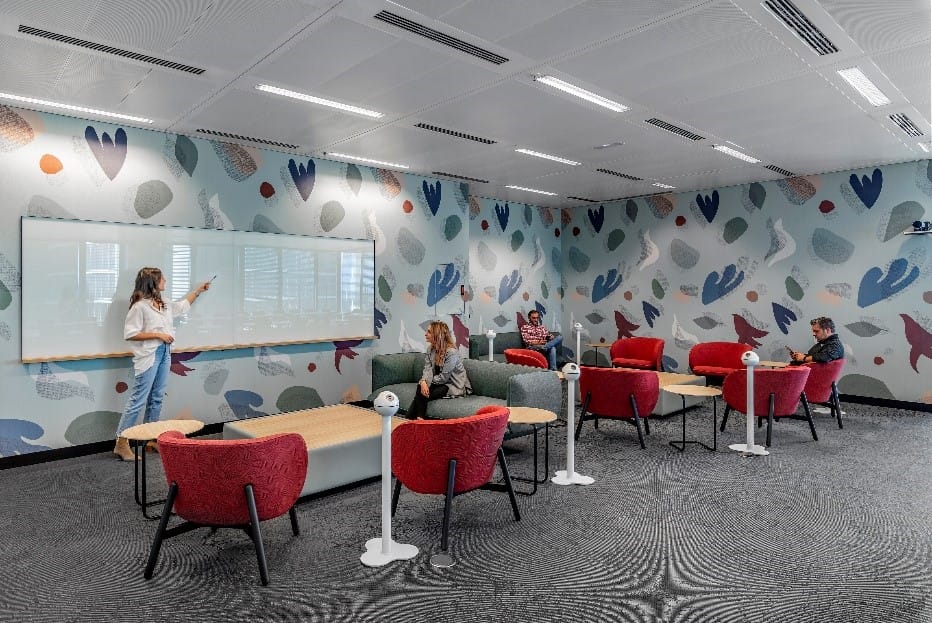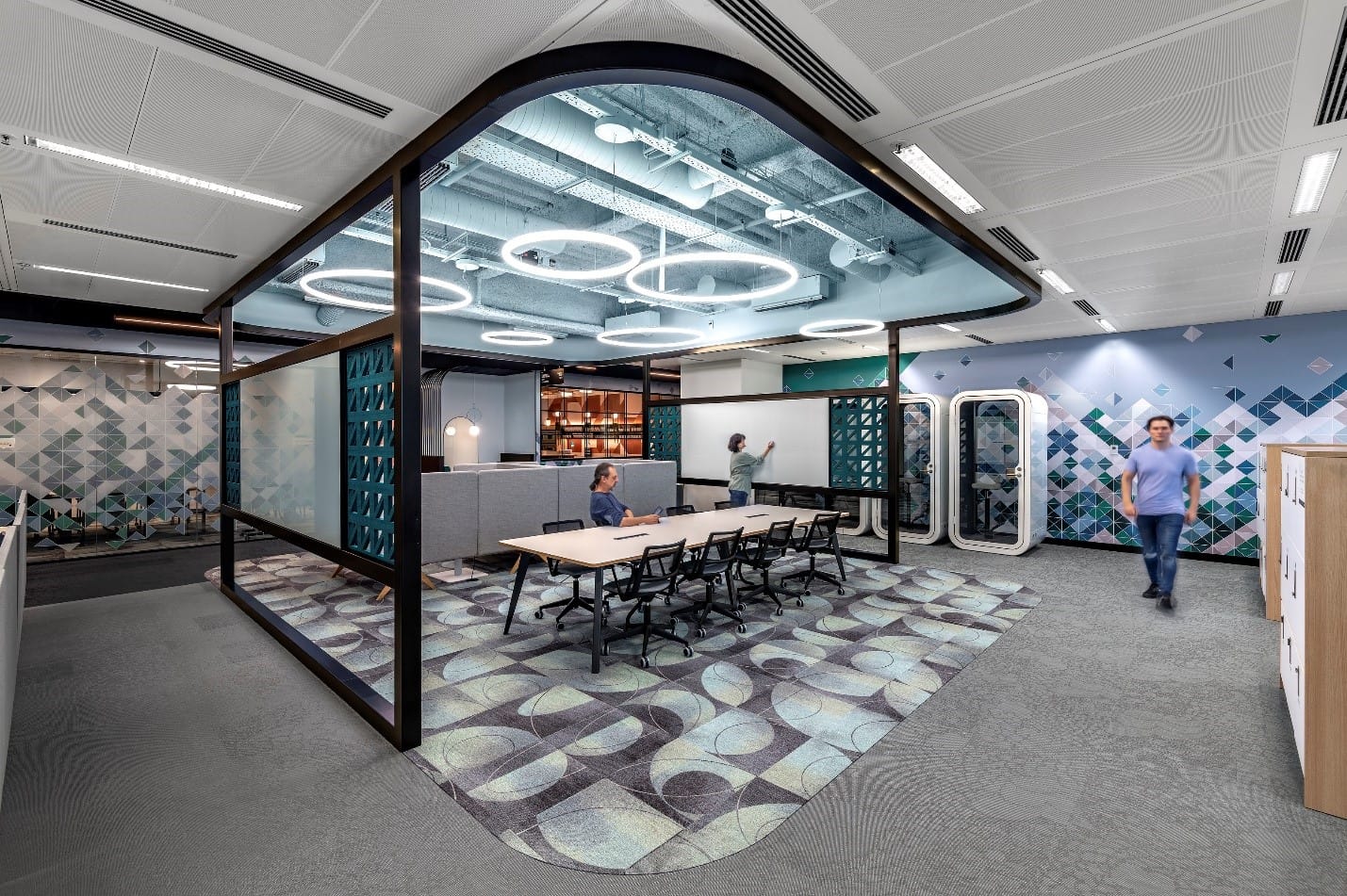By Russell Manthy | Principal
The last year has challenged many organizations to keep their teams engaged, with training and learning not the least of their concerns. Although formal learning at work is not new, recent events and science-based research point to an evolved approach to learning that affects both presentation and environment and suggests significant change. We take a look at learning, and the changes that might be in store for corporate educational and training spaces.
Early Ideas: SCALE-UP and TEAL
Educators in academic and corporate environments have long struggled to evolve learning beyond the traditional classroom style that features a single instructor addressing a group. Over time, many studies have indicated that team and group learning had potential as a more effective method of teaching. Two of the earliest organizations to realize that potential, and shape a space around it were North Carolina State and M.I.T.

The SCALE-UP programs rely on student-led learning.
In the late 90s, North Carolina State developed its Student-Centered Active Learning Environment for Undergraduate Programs (SCALE-UP) initiative. The initial concept centered around creating a place where student teams would be given topics to investigate while an instructor provided support and fostered conversation as opposed to directly managing the learning. Teams were seated at round tables and had whiteboards nearby for ideation. By today’s standards, this sounds pretty simple, but it was revolutionary at the time.

M.I.T., home of the TEAL initiative.
In 2000 M.I.T. followed suit by forming the TEAL (Technology Enhanced Active Learning) program and created a classroom environment based on group and team learning. The room featured an instructor workstation in the center surrounded by several tables, each seating nine students. The nine students were divided into three groups with varying levels of experience with the subject matter. This last step was critical to facilitating peer instruction, allowing students to synthesize information rather than memorize it.
The teaching methods in the TEAL program were shown to produce about twice the average normalized learning gains for most groups of students. The program gained considerable notoriety in the academic world and was copied and adapted by a number of learning institutions across the country.

A recent, Confidential IA Client’s collaborative learning space can be seen here. Photography © Jose F. Parreño.
This type of classroom setting is representative of the current increased emphasis on group work and learning. Students whose educational experience largely followed this type of instruction style are now bringing that expectation into the workplace. IA clients that have adopted this methodology and associated space types in their corporate training programs have seen the successes of the academic world transfer to their corporate learning programs.
But there is more to the puzzle than just space and an academic framework.
Recent Research Has Uncovered Some Interesting Ideas About Learning
For instance, more information does not necessarily mean more learning. The brain has to work to understand and process new information, and this takes up cognitive resources. The presentation of additional information does not always correspond to a linear increase in learning. When too much is presented, neuroscientists describe a state of cognitive overload, which ultimately reduces learning. This overload can be mitigated by changing how information is presented to make it less overwhelming or by simply presenting less new information in each session. Such adjustments may require that the learning be undertaken in smaller increments, but this approach may be more effective for engagement and retention in the long run.
Emotions also play a role in how people learn, affecting how we perceive information, react, and remember it. Feelings of anxiety, stress, or fear are the worst emotional states for learning. Creating a positive environment for learning by promoting a safe learning culture where people are free to express their thoughts and ideas without worry of rebuke is key. If you establish a comfortable, welcoming, and egalitarian space, the physical environment contributes to reinforcing this idea.
Making mistakes is essential for learning. Sometimes the pressure to succeed can inhibit the learning process. Reinforcing the idea that failure is a normal and expected part of the learning process and not emphasizing errors can make the learning process more effective.
Presenting information in a novel and diverse way is also vital to successful learning. Boredom is a significant factor in deterring learning. When information is presented in the same way repeatedly, learners tend to lose focus and attention. Coming up with a variety of ways to vary the format of the information presented is critical to retaining students' attention. Flexible learning environments that allow students to change settings and positions during the learning process can support this approach.

Photography © Garrett Rowland.
Gamification
Gamification refers to the application of gameplay elements in non-game settings and has been utilized to boost engagement. Games are sometimes custom-designed to drive social, marketing, or business goals. Game designers can work with organizations to understand the desired learning outcomes and then craft games around those specific goals. The use of narrative frameworks, level advancement, and other game-driven tasks can increase engagement. New tools such as virtual and augmented reality can also support and enhance this type of learning experience.
The Past Months
The past year and a half have been an enormous challenge for businesses and individuals at many levels. How to keep employees learning and growing while working largely remotely has challenged many organizations. A recent study found that employees were motivated to develop new skills as a result of changes during the past year. Yet, they are unlikely to participate in a corporate learning program if it does not reflect their personal and professional goals.
Past employee learning programs tended to put little emphasis on understanding whether employees wanted to learn the things they were being taught. Instead, programs focused on what the companies thought teams should know. Some firms are now using experience management technology to poll employees on what and how they want to learn, leading to more tailored learning. One of the positive outgrowths of last year’s challenges is that the technology to support more individualized and curated learning has developed more rapidly than anticipated.
An essential aspect of learning, development, and growth is the social relationships that support those processes. Connecting people with shared goals and interests can foster mentoring and other benefits. While connecting online is possible, people have bandwidth limitations for online meetings and social interactions. These limitations may have caused learning processes to suffer in a remote work environment. Once people are back at the workplace in an environment that allows for building social capital among colleagues, learning will be vital to jumpstarting these processes.
In some cases, personal and professional development has been put on hold as workers pick up the tasks of furloughed colleagues or put extra energies into keeping their business afloat.
Many companies will allow some flexibility in how people return to the office. Still, the idea of a hybrid work or learning environment with some participants present and some remote cannot always be ideal. People together at the office have an advantage over those who are remote because they are better positioned to pick up the subtle emotional cues that are easily missed without live interaction. In addition, they're better able to take part in or overhear side conversations than a digital training scenario might enable. When designing a learning program and a physical learning environment, it will be critical to understand these factors.
How Does this Apply to Space?

Confidential Client, Chicago. Photography © Garrett Rowland.
As we have noted, many factors go into the creation of a thriving learning environment. Some elements are based on space. Others are based on the design of the materials and the structure of the program itself.
In thinking about how to create a space that supports an organization's physical, academic, and emotional needs, there are a number of things to consider. Spaces need to be flexible and easily reconfigured to support multiple learning styles, including collaborative learning, more traditional classroom environments, and breakout groups. Audiovisual systems should be designed to support the environment in a variety of configurations so that their placement does not impair the rearrangement of the space. The quality of the audiovisual systems needs to be carefully considered since there may be a combination of in-person and remote learners present. The experience of both should be as closely aligned as possible.
A training area at a Confidential IA Tech Client. Madrid. Photography © Jose F. Parreño.
The support of emotional wellbeing is also key to the success of a learning environment. The materiality of the spaces needs to be calm and not distracting. While furniture must be flexible, comfort should not be sacrificed. Learning sessions can be long and even last over days and weeks. Providing furniture that is both ergonomic and comfortable is essential. In the past, learning environments were often placed at interior locations to control lighting for audiovisual presentations. This approach may no longer be necessary thanks to the adoption of modern digital displays.
Bringing natural light into the learning environment will greatly benefit participants. Also, reasonable lighting control is needed so that the level of illumination can be adjusted to accommodate different types of learning, educational tools, etc.
Adjacent support can be just as critical to a thriving learning environment as the classroom setting itself. The placement of comfortable lounge and breakout spaces nearby allows teams to take relaxing breaks, which are essential to maintaining focus and reducing stress. Areas for refreshments and snacks should be close as well.
Conclusion
What we have learned from both the academic world and the last year and a half of remote work can help to enhance the learning process and the environments in which learning happens. But it is worth noting that even the best and most well-tuned physical learning environment designed with expertise needs to be complemented by an engaging and empathetic learning program.
